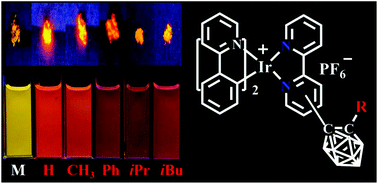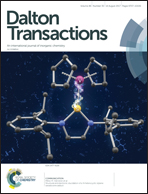Novel phosphorescent cationic iridium(iii) complexes with o-carboranylation on the ancillary N^N ligand†
Abstract
A novel series of heteroleptic iridium complexes with 2-phenyl-pyridine as a main ligand and carborane-functionalized 2,2′-bipyridine as an ancillary ligand were synthesized, and characterized as [Ir(ppy)2(By)]PF6 (where ppy is 2-phenyl-pyridine, By is 5-(2-R-Cb)-2,2′-bipyridine, R = H (2a), CH3 (2b), Ph (2c), iPr (2d) and iBu (2e), or By is 4-(2-R-Cb)-2,2′-bipyridine while R = H (3a), CH3 (3b), Ph (3c), iPr (3d) and iBu (3e), Cb = o-carboran-1-yl). The R groups and the substitution sites of carborane on the pyridine ring have caused differences in the emission properties of these complexes. In addition, the quantum efficiency of [Ir(ppy)2(By)]PF6 complexes has been tuned as well through the introduction of various 2-R-substituted o-carboranes into the ancillary ligand 2,2′-bipyridine, no matter in the solid state (from 0.12 to 0.25) or in solution (from 0.04 to 0.25). The emission color was tuned from yellow to red by the o-carboranyl unit because of its inductive effect. Density functional theory (DFT) and time dependent DFT (TD-DFT) calculations have been applied to investigate excited-state electronic structures of the newly synthesized complexes, which are consistent with the observed red-shift emissions.



 Please wait while we load your content...
Please wait while we load your content...